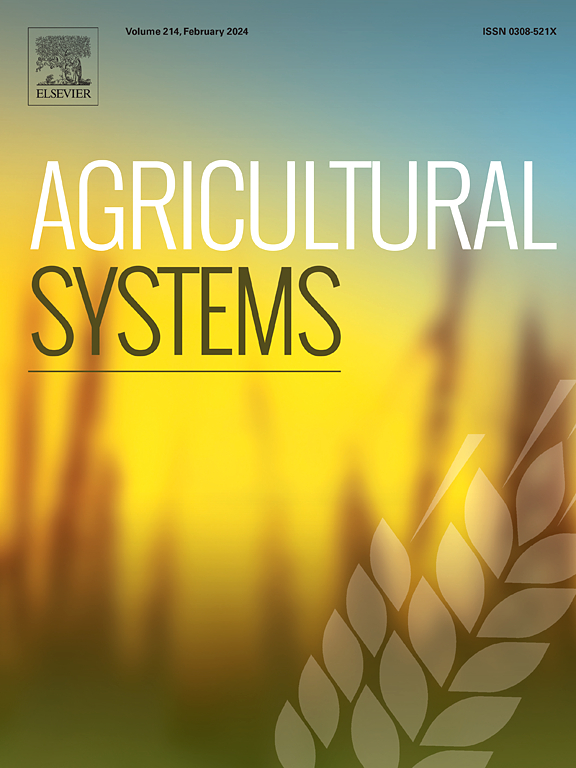Economic and climate effects of farm-level biogas adoption: A stochastic partial budget analysis and life cycle assessment for Swedish dairy farming
IF 6.1
1区 农林科学
Q1 AGRICULTURE, MULTIDISCIPLINARY
引用次数: 0
Abstract
CONTEXT
There is a growing interest in investments in technology that can help farms to become fossil-free, without compromising their economic incentives, and while significantly reducing greenhouse gas (GHG) emissions. Biogas is an interesting technology in this respect, however, the possible farm-level economic impacts from investing in a biogas-based system are not well understood, yet they are decisive to understand farmers' incentives for adoption.
OBJECTIVE
The objectives are to i) develop a scenario which allows the farms to become fossil-free in their input use, ii) assess the farm-level economic consequences of adoption and iii) quantify change in global warming potential in a 100-year period (GWP100) from the biogas-scenario.
METHODS
We use a stochastic partial budgeting approach to simulate farm-level economic benefits and costs associated with changes and uncertainty related to economic effects. We also use life cycle assessment for the quantification of the climate effects, which enable us to examine the potential climate impact in reduction of fossil-based inputs in baseline scenario by transitioning to the biogas scenario. The study is based on simulation for a hypothetical dairy farm with 300 milking cow and a corresponding 325 ha of arable land that produces 75 % mixed grass and 25 % clover.
RESULTS AND CONCLUSIONS
The result shows that transitioning to a biogas-based system will yield an estimated deterministic net annual benefit of 1035 SEK for the hypothetical farm. However, when considering simulated scenario, the net annual benefit could be negative, amounting −5398 SEK. Besides, there could be a gain of 185,000 SEK from yet unpaid carbon credits, which could be shared between the farm and the biogas plant. In addition, the biogas-system also results in a 218.4 t reduction of CO2 eq. emission. Therefore, if all milk-recorded cows in Sweden were considered to be part of the biogas system, it theoretically will imply a 27 % reduction in GHG emissions from the use of agricultural machinery. Results thus established that adopting the biogas-based system will not only result in cost-neutral to farmers, but also a considerable reduction in methane emissions.
SIGNIFICANCE
The paper provides a joint farm-level economic and climate assessment of transition from conventional dairy farm to a biogas system, highlighting potential trade-offs and synergies between the two outcomes. Our result offers valuable understanding about how market internalisation of fossil-free transition in dairy farming can happen through the creation of economic and business incentives that encourage trading between farmers and biogas plants.

农场采用沼气的经济和气候影响:瑞典奶牛养殖的随机部分预算分析和生命周期评估
人们对技术投资的兴趣日益浓厚,这些技术可以帮助农场在不损害其经济激励的同时,显著减少温室气体(GHG)排放。在这方面,沼气是一项有趣的技术,然而,投资沼气系统可能对农场层面的经济影响尚未得到很好的理解,但它们对了解农民采用沼气的动机具有决定性作用。目标:1)制定一个情景,允许农场在投入物使用中不使用化石燃料;2)评估采用该情景的农场层面经济后果;3)量化100年期间沼气情景的全球变暖潜能值变化(GWP100)。方法我们使用随机部分预算方法来模拟与经济效应相关的变化和不确定性相关的农场层面的经济效益和成本。我们还使用生命周期评估来量化气候影响,这使我们能够通过过渡到沼气情景来检查基线情景中减少化石燃料投入的潜在气候影响。这项研究是基于一个假设的奶牛场的模拟,该奶牛场有300头奶牛,相应的325公顷耕地,生产75%的混合草和25%的三叶草。结果与结论结果表明,过渡到以沼气为基础的系统将为假设的农场产生估计的确定性净年效益1035瑞典克朗。然而,当考虑模拟场景时,净年效益可能为负,总计为- 5398瑞典克朗。此外,还可以从尚未支付的碳信用中获得18.5万瑞典克朗的收益,这可以在农场和沼气厂之间共享。此外,沼气系统还减少了218.4吨的二氧化碳当量排放。因此,如果瑞典所有有产奶记录的奶牛都被认为是沼气系统的一部分,理论上将意味着农业机械使用的温室气体排放量减少27%。结果表明,采用沼气为基础的系统不仅可以为农民带来成本平衡,而且可以大大减少甲烷排放。本文提供了从传统奶牛场向沼气系统过渡的农场层面的经济和气候联合评估,强调了两种结果之间的潜在权衡和协同效应。我们的研究结果提供了有价值的理解,即如何通过创造鼓励农民和沼气厂之间交易的经济和商业激励措施,实现奶牛养殖中无化石转型的市场内在化。
本文章由计算机程序翻译,如有差异,请以英文原文为准。
求助全文
约1分钟内获得全文
求助全文
来源期刊

Agricultural Systems
农林科学-农业综合
CiteScore
13.30
自引率
7.60%
发文量
174
审稿时长
30 days
期刊介绍:
Agricultural Systems is an international journal that deals with interactions - among the components of agricultural systems, among hierarchical levels of agricultural systems, between agricultural and other land use systems, and between agricultural systems and their natural, social and economic environments.
The scope includes the development and application of systems analysis methodologies in the following areas:
Systems approaches in the sustainable intensification of agriculture; pathways for sustainable intensification; crop-livestock integration; farm-level resource allocation; quantification of benefits and trade-offs at farm to landscape levels; integrative, participatory and dynamic modelling approaches for qualitative and quantitative assessments of agricultural systems and decision making;
The interactions between agricultural and non-agricultural landscapes; the multiple services of agricultural systems; food security and the environment;
Global change and adaptation science; transformational adaptations as driven by changes in climate, policy, values and attitudes influencing the design of farming systems;
Development and application of farming systems design tools and methods for impact, scenario and case study analysis; managing the complexities of dynamic agricultural systems; innovation systems and multi stakeholder arrangements that support or promote change and (or) inform policy decisions.
 求助内容:
求助内容: 应助结果提醒方式:
应助结果提醒方式:


